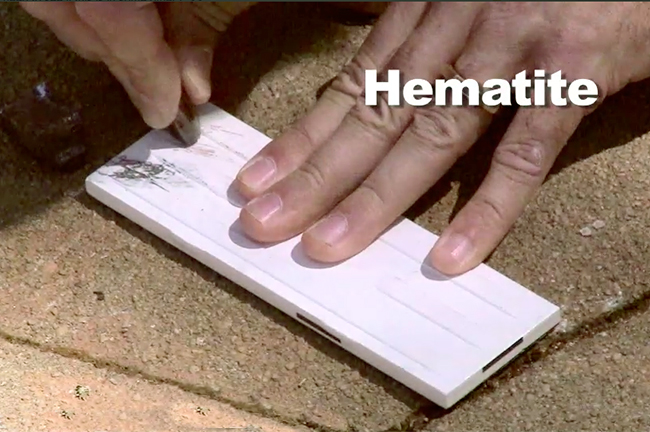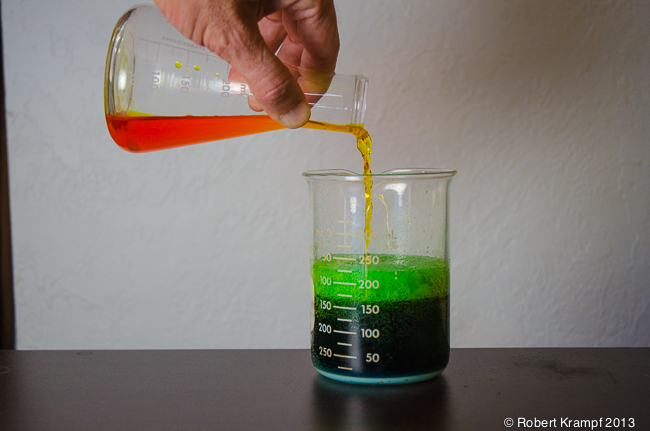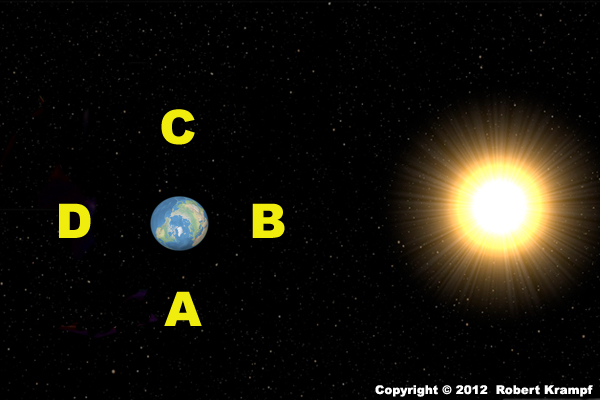Here are some science questions to help you test your general science knowledge. They will also show you which of the Florida, Utah, and NGSS science standards each question is testing.
The questions are chosen randomly, so this quest will be different each time.
Get 5 more random questions.
Would you rather see the most recently added questions?

One test for identifying minerals involves rubbing the mineral on a rough tile, and looking at the color of the mark it leaves. This test is called:
-
Cleavage
No. Cleavage is when a mineral breaks along planes of weakness to form flat surfaces. -
Hardness
No. Hardness is the resistance of a mineral to being scratched by other substances. -
Fracture
No. Fracture is when a mineral breaks but does not show cleavage. -
Streak
Yes. The streak test examines the color of the mineral when it is powdered by rubbing it on a rough tile or streak plate. While the actual color of a mineral can vary, it will always produce the same color streak.
Click to see which state standards this question tests, and which of my videos, experiments, and other resources support that topic.
Florida
SC.4.E.6.2 Identify the physical properties of common earth-forming minerals, including hardness, color, luster, cleavage, and streak color, and recognize the role of minerals in the formation of rocks.
| What is a Mineral? | video, checked |
| Identifying Minerals | video, learnalong |
| Definition of a Mineral | video, checked |
| Minerals Around You | text page, learnalong, checked |
| Review Minerals-1 | practice |
| Review Minerals-2 | practice |
| Review Minerals-3 | practice |
| Review Minerals-4 | practice |
| Review Minerals-5 | practice |
| Review Minerals-6 | practice |
| Review Minerals-7 | practice |
| Review Minerals-8 | practice |
Utah
UT.8.III.1.b Observe and describe the minerals found in rocks (e.g., shape, color, luster, texture, hardness).
| What is a Mineral? | video, checked |
| Identifying Minerals | video, learnalong |
| What is a Rock? | video, learnalong, checked |
| Definition of a Mineral | video, checked |
| Review Minerals-1 | practice |
| Review Minerals-2 | practice |
| Review Minerals-3 | practice |
| Review Minerals-4 | practice |
| Review Minerals-5 | practice |
| Review Minerals-6 | practice |
| Review Minerals-7 | practice |
| Review Minerals-8 | practice |
NGSS

When a scientist makes a new discovery, other scientists usually do exactly the same experiment. Why?
-
They want to get part of the credit.
No. While replicating an experiment is very important, the scientists who do it usually don't get much credit for their work unless they discover an error in the original experiment. -
Repetition is part of the scientific process.
No. Repetition is when scientists repeat their own experiment several times, not when other scientists do the same experiment. -
They think they can make changes to improve the experiment.
No. By doing exactly the same experiment, they are not changing anything. Instead, they are replicating the experiment as closely as possible. -
Replication is part of the scientific process.
Yes. By replicating the experiment, other scientists can help verify that the results are accurate. There is always a possibility that there was some unnoticed influence on the original experiment, and replication can help spot that.
Click to see which state standards this question tests, and which of my videos, experiments, and other resources support that topic.
Florida
SC.2.N.1.4 Explain how particular scientific investigations should yield similar conclusions when repeated.
| What is Science? | video, ClosedCaptions |
| Review Scientific Process-6 | practice |
| Review Scientific Process-5 | practice |
| Review Scientific Process-7 | practice |
| Review Scientific Process-10 | practice |
SC.5.N.2.2 Recognize and explain that when scientific investigations are carried out, the evidence produced by those investigations should be replicable by others.
>>> Teacher Page: Nature of Science and Dissolving
| What is Science? | video, ClosedCaptions |
| What is Science?: Repeat and Replicate | video |
| Review Scientific Process-6 | practice |
| Review Scientific Process-5 | practice |
| Review Scientific Process-10 | practice |
SC.6.N.1.2 Explain why scientific investigations should be replicable.
| What is Science? | video, ClosedCaptions |
| What is Science?: Repeat and Replicate | video |
| Review Scientific Process-6 | practice |
| Review Scientific Process-5 | practice |
SC.7.N.1.2 Differentiate replication (by others) from repetition (multiple trials).
| What is Science? | video, ClosedCaptions |
| What is Science?: Repeat and Replicate | video |
| Review Scientific Process-6 | practice |
| Review Scientific Process-5 | practice |
SC.8.N.1.2 Design and conduct a study using repeated trials and replication.
| What is Science?: Repeat and Replicate | video |
| Review Scientific Process-6 | practice |
| Review Scientific Process-5 | practice |
| Review Scientific Process-7 | practice |
| Review Scientific Process-10 | practice |
Utah
NGSS

Which position would the Moon be in during an eclipse of the Sun?
-
A
No. In this position, the Earth would not be in the Moon's shadow. -
B
Yes! Solar eclipses only happen during a new moon, but even then, the alignment has to be just right for the Moon's shadow to fall on the Earth. -
C
No. In this position, the Earth would not be in the Moon's shadow. -
D
No. In this position, the Earth would not be in the Moon's shadow. You might get a lunar eclipse in this position, but not a solar eclipse.
Click to see which state standards this question tests, and which of my videos, experiments, and other resources support that topic.
Florida
SC.4.E.5.2 Describe the changes in the observable shape of the moon over the course of about a month.
| Why is a Full Moon So Bright? | text page, free, checked |
| Review Space-6 | practice |
| Review Space-7 | practice |
| Review Space-9 | practice |
Utah
UT.3.I.1.b Explain that the sun is the source of light that lights the moon.
| Why is a Full Moon So Bright? | text page, free, checked |
| Review Space-6 | practice |
| Review Space-7 | practice |
| Review Space-9 | practice |
UT.6.I.1.a Describe changes in the appearance of the moon during a month.
| Why is a Full Moon So Bright? | text page, free, checked |
| Review Space-6 | practice |
| Review Space-7 | practice |
| Review Space-9 | practice |
NGSS
MS-ESS1-1 Develop and use a model of the Earth-sun-moon system to describe the cyclic patterns of lunar phases, eclipses of the sun and moon, and seasons.
| Global Science | video, ClosedCaptions |
| Why is a Full Moon So Bright? | text page, free, checked |
| Review Space-6 | practice |
| Review Space-7 | practice |
| Review Space-9 | practice |
| Review Space-12 | practice |

While this spoon appears to have a broken handle, it is just the result of how the water affects the light. This is an example of:
-
Refraction
Yes! Refraction bends light as it moves from one substance to another. As the light passes from the water to the air, its path is changed, making it appear that the spoon is broken. -
Reflection
No. While some light is reflected from the glass, it is not responsible for the bending of the light. -
Absorption
No. The water and glass are both clear, telling us that very little of the light is being absorbed. Absorption does not bend the light. -
Diffusion
No. Diffusion is the scattering of light as it is reflected in many different directions. Diffusion would make the image cloudy and blurry.
Click to see which state standards this question tests, and which of my videos, experiments, and other resources support that topic.
Florida
SC.3.P.10.3 Demonstrate that light travels in a straight line until it strikes an object or travels from one medium to another.
| Sunglass Science: Birefringence | video, free, Updated |
| Sunglass Science: Polarized Light | video, free, Updated |
| Mirage | video, free, ClosedCaptions, Updated |
| Pinhole Eyeglasses | video, checked |
| Why Wet Things Turn Dark | video, checked |
| Growing Crystals Under the Microscope | video, free, learnalong, checked |
| Changing the Speed of Light | video |
| Why is Foam White? | video, checked |
| Microscopes: Growing Crystals | video, free, learnalong, Updated |
| A Long Lens | text page |
| Review Light-1 | practice |
| Review Light-2 | practice |
| Review Light-3 | practice |
| Review Light-4 | practice |
| Review Light-5 | practice |
SC.3.P.10.4 Demonstrate that light can be reflected, refracted, and absorbed.
| Sunglass Science: Birefringence | video, free, Updated |
| Sunglass Science: Polarized Light | video, free, Updated |
| Mirage | video, free, ClosedCaptions, Updated |
| Pinhole Eyeglasses | video, checked |
| Looking for Rainbows | video |
| Why Wet Things Turn Dark | video, checked |
| Growing Crystals Under the Microscope | video, free, learnalong, checked |
| Changing the Speed of Light | video |
| Why is Foam White? | video, checked |
| Onion Crystals | video |
| Microscopes: Growing Crystals | video, free, learnalong, Updated |
| A Long Lens | text page |
| Sunlight, Energy, and Crayons | text page, free |
| Review Light-1 | practice |
| Review Light-2 | practice |
| Review Light-3 | practice |
| Review Light-4 | practice |
| Review Light-5 | practice |
SC.7.P.10.2 Observe and explain that light can be reflected, refracted, and/or absorbed.
| Microscopes: Growing Crystals | video, free, learnalong, Updated |
| Sunglass Science: Birefringence | video, free, Updated |
| Sunglass Science: Polarized Light | video, free, Updated |
| Mirage | video, free, ClosedCaptions, Updated |
| Pinhole Eyeglasses | video, checked |
| Why Wet Things Turn Dark | video, checked |
| Growing Crystals Under the Microscope | video, free, learnalong, checked |
| Finding Fat in Foods | video, ClosedCaptions, checked |
| Changing the Speed of Light | video |
| Why is Foam White? | video, checked |
| Onion Crystals | video |
| A Long Lens | text page |
| Sunlight, Energy, and Crayons | text page, free |
| Review Light-1 | practice |
| Review Light-2 | practice |
| Review Light-3 | practice |
| Review Light-4 | practice |
| Review Light-5 | practice |
Utah
UT.8.IV.1.b Compare the transfer of energy (i.e., sound, light, earthquake waves, heat) through various mediums.
| Microwave Chocolate | video, checked |
| Spoon Bells | video, checked |
| The Singing Glass | video, checked |
| Why Wet Things Turn Dark | video, checked |
| The Science of Pizza | video, checked |
| Heating a Balloon | video, ClosedCaptions, checked |
| Changing the Speed of Light | video |
| Doppler Effect | video, checked |
| Solar Power | video, checked |
| Sunglass Science: Birefringence | video, free, Updated |
| Sunglass Science: Polarized Light | video, free, Updated |
| Noisy String | video, checked |
| Mirage | video, free, ClosedCaptions, Updated |
| About Microwaves | video, checked |
| Comparing How Sound Moves Through Liquids and Gases | text page |
| Review Light-1 | practice |
| Review Light-2 | practice |
| Review Light-4 | practice |
| Review Light-5 | practice |
NGSS
1-PS4-3 Plan and conduct an investigation to determine the effect of placing objects made with different materials in the path of a beam of light.
| Pinhole Eyeglasses | video, checked |
| Why Wet Things Turn Dark | video, checked |
| Growing Crystals Under the Microscope | video, free, learnalong, checked |
| Sunprints | video |
| Changing the Speed of Light | video |
| Why is Foam White? | video, checked |
| Onion Crystals | video |
| Microscopes: Growing Crystals | video, free, learnalong, Updated |
| Sunglass Science: Birefringence | video, free, Updated |
| Sunglass Science: Polarized Light | video, free, Updated |
| Mirage | video, free, ClosedCaptions, Updated |
| A Color You Can't See | video, free, checked |
| A Long Lens | text page |
| Review Light-1 | practice |
| Review Light-2 | practice |
| Review Light-3 | practice |
| Review Light-4 | practice |
| Review Light-5 | practice |
MS-PS4-2 Develop and use a model to describe that waves are reflected, absorbed, or transmitted through various materials.
| Microwave Chocolate | video, checked |
| Why Wet Things Turn Dark | video, checked |
| Onion Crystals | video |
| Sunprints | video |
| Finding Fat in Foods | video, ClosedCaptions, checked |
| Changing the Speed of Light | video |
| Why is Foam White? | video, checked |
| Sunglass Science: Birefringence | video, free, Updated |
| Sunglass Science: Polarized Light | video, free, Updated |
| Mirage | video, free, ClosedCaptions, Updated |
| About Microwaves | video, checked |
| A Long Lens | text page |
| Sunlight, Energy, and Crayons | text page, free |
| Review Light-1 | practice |
| Review Light-2 | practice |
| Review Light-4 | practice |
| Review Light-5 | practice |

I want to test a new fertilizer, to find the best concentration for my garden. To do this, I plan to divide my garden into four sections.
Section A. I will use 5 grams of fertilizer per gallon each time I fertilize.
Section B. I will use 10 grams of fertilizer per gallon each time I fertilize.
Section C. I will use 15 grams of fertilizer per gallon each time I fertilize.
For section D, how much fertilizer per gallon should I use?
-
20 grams of fertilizer per gallon.
No. This would be a good thing to test, but for this to be a proper science experiment, it is not the correct answer. -
30 grams of fertilizer per gallon.
No. This would be a good thing to test, but for this to be a proper science experiment, it is not the correct answer. -
1 gram of fertilizer per gallon.
No. This would be a good thing to test, but for this to be a proper science experiment, it is not the correct answer. -
No fertilizer at all.
Yes. For this type of experiment, you need to have a control group. That is a group of test subjects that you do not do anything to. If the control group with no fertilizer grows just as well as the other groups, then I would know that the fertilizer was not working.
Click to see which state standards this question tests, and which of my videos, experiments, and other resources support that topic.
Florida
SC.5.N.1.4 Identify a control group and explain its importance in an experiment.
| Bacteria and Antibiotics | video, ClosedCaptions |
| Testing a Leaf for Starch | video, ClosedCaptions |
| Review Scientific Process-1 | practice |
| Review Scientific Process-2 | practice |
| Review Scientific Process-9 | practice |
| Review Scientific Process-11 | practice |
SC.7.N.1.4 Identify test variables (independent variables) and outcome variables (dependent variables) in an experiment.
| Floating Cups | video, checked |
| Testing for Tannic Acid | video |
| Review Scientific Process-1 | practice |
| Review Scientific Process-2 | practice |
| Review Scientific Process-9 | practice |
| Review Scientific Process-11 | practice |
Utah
NGSS
3-5-ETS1-3 Plan and carry out fair tests in which variables are controlled and failure points are considered to identify aspects of a model or prototype that can be improved.
| What is Science? | video, ClosedCaptions |
| Review Scientific Process-1 | practice |
| Review Scientific Process-2 | practice |
| Review Scientific Process-7 | practice |
| Review Scientific Process-9 | practice |
| Review Scientific Process-10 | practice |
| Review Scientific Process-11 | practice |
The questions are chosen randomly, so this quest will be different each time.
